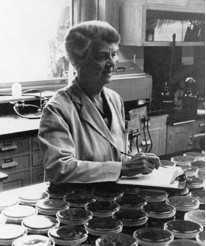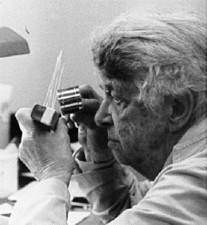Masterminding Bacterial Classification
 Lancefield, Rebecca
Lancefield, RebeccaCourtesy of the Rockefeller Archive Center
When Rebecca Lancefield (1895-1981) began studying the bacteria known as hemolytic streptococci, no one recognized that these microbes caused common—and dangerous—human diseases such as "strep throat," scarlet fever, rheumatic fever, acute kidney disease, and impetigo. Beginning in 1918, and continuing over the course of six decades, Lancefield devised a system for classifying the dozens of types of streptococcal bacteria. This system, still in use today, laid the groundwork for understanding the clinical course of these diseases and how they are transmitted.
A turning point came in the mid-1920s when Lancefield recognized that streptococci carry a protein on their cell surface that is correlated with virulence. Lancefield called this the M protein, and classified types of streptococci based on variations in this protein, as determined by their reactions with different antisera. She also found that the M protein prevents human white blood cells from engulfing and destroying streptococci unless an antibody is present to neutralize this effect. This explained why repeated strep throats, for example, are so common in childhood—immunity to one streptococcus does not prevent infection with another type.
During World War II, Lancefield's laboratory became known as the "Scotland Yard of streptococcal mysteries," as she worked with the Naval Medical Center, the Army's Board for Investigation of Epidemic Diseases, and others to type bacterial cultures isolated from patients in military hospitals. The evidence from the thousands of cultures that she typed informed later studies on streptococcal epidemiology and the mechanism by which rheumatic fever develops after a streptococcal infection with scarlet fever. The data also led to a practical immediate recommendation for less crowded barracks to reduce the chance of infectious outbreaks.
 Lancefield, Rebecca
Lancefield, RebeccaCourtesy of the Rockefeller Archive Center
Rebecca Lancefield received the BA from Wellesley College (1916) and the PhD from Columbia University (1925). She began her work on hemolytic streptococci in the laboratory of Oswald T. Avery in 1918. She left the next year, after Avery's project was completed, but returned to the Rockefeller Hospital in 1922 as an assistant in the laboratory of Homer Swift. She remained at Rockefeller for the rest of her career, rising to the title of professor in 1958. Lancefield served as president of the Society of American Bacteriologists and of the American Association of Immunologists. She was elected to the U.S. National Academy of Sciences, and her work was recognized by, among other awards and honorary degrees, the American Heart Association Achievement Award.
Selected Publications
Dochez AR, Avery OT and Lancefield RC. Studies on the biology of streptococcus. I. Antigenic relationship between strains of Streptococcus haemolyticus. J Exp Med, 1919, 30: 179
http://www.jem.org/cgi/reprint/30/3/179
Lancefield RC 1928. The antigenic complex of Streptococcus haemolyticus. I. Demonstration of a type-specific substance in extracts of Streptococcus haemolyticus.
J Exp Med, 1928, 47:91-103; II. Chemical and immunological properties
of the protein fractions, 469-480; III. Chemical and immunological
properties of the species-specific substance, 481-491; IV. Anaphylaxis
with two non-type specific fractions, 843-855; V. Anaphylaxis with the
type-specific substance, 857-875
http://www.jem.org/cgi/reprint/47/1/91
Swift, HF, Wilson AT, and Lancefield RC. Typing group A hemolytic
streptococci by M precipitin reaction in capillary pipettes. J Exp Med,
1943, 78:127
http://www.jem.org/cgi/reprint/78/2/127
Further Reading
McCarty M. Rebecca Craighill Lancefield (1895-1981): A Biographical Memoir. Washington, DC: National Academy of Sciences, 57: 226-246
Rebecca Craighill Lancefield (1895-1981)
http://www.rockefeller.edu/vaf/rclbio.htm
Links
The Lancefield Collection of Streptococcus Strains
http://www.rockefeller.edu/vaf/lanceindex.php
